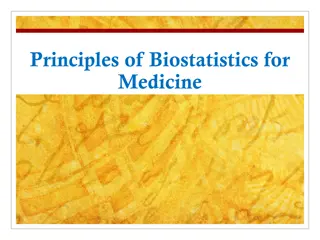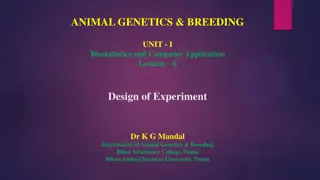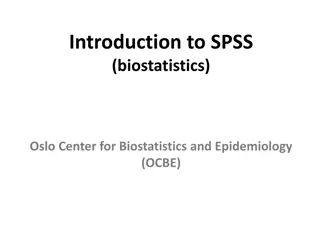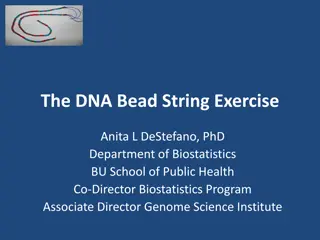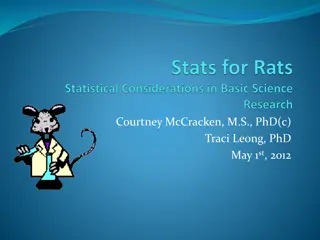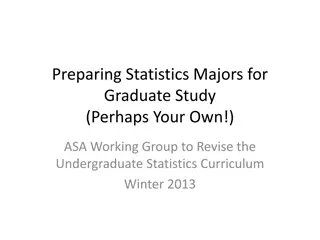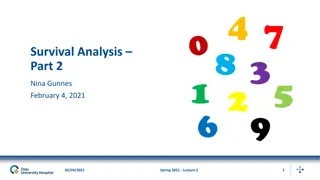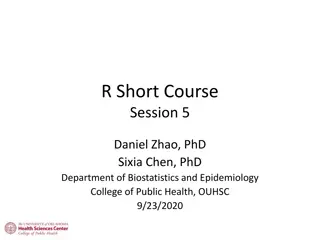Proposal for Joint Master's Programme in Biostatistics and Data Science at FMS Spring Meeting
This proposal outlines the creation of a 120-credit joint Master's programme in biostatistics and data science to address the lack of such a programme in Sweden. Developed by a committee from Karolinska Institutet, KTH, and Stockholm University, the programme aims to start in HT2024 with a focus on
1 views • 12 slides
Biostatistician Expert Offering Statistical Support and Training at CAMH
Marcos Sanches is a biostatistician at Biostatistic Core, CAMH, dedicated to enhancing the statistical quality of research projects. With expertise in various study designs, statistical techniques, and software, Marcos provides support throughout the project lifecycle, from grant applications to dat
5 views • 7 slides
Research Methodology
The Research Methodology course is a mandatory requirement for HST trainees, involving four modules to be completed in ST3 and ST4. Taught by Dr. Rose Galvin via Moodle, the course covers topics such as evidence-based medicine, study design, bias, systematic reviews, biostatistics, and presentation
1 views • 13 slides
Challenges in MMRM Analysis: Insights from Biostatistics Research
In this informative piece authored by Moses Mwangi from KEMRI, the limitations and challenges of Mixed Models Repeated Measures (MMRM) analysis are discussed. The content covers the introduction to MMRM, model formulation, motivating case studies, and concluding remarks. The article delves into the
1 views • 24 slides
Understanding Biostatistics in Medicine
Biostatistics is essential in analyzing medical and biological data to provide evidence for clinical decisions. It plays a crucial role in describing patients, evaluating treatment outcomes, and forming the foundation of Evidence-Based Medicine. By applying statistical methods, biostatistics helps i
1 views • 5 slides
Understanding Quantitative Decision Making in Biostatistics
Quantitative Decision Making (QDM) in biostatistics enables optimal design of development plans and studies, quantifies decision risks, and minimizes bias. It involves setting targets and evidence levels, anchoring outcomes against targets, and establishing evidence thresholds for positive and negat
0 views • 27 slides
Design of Experiment in Animal Genetics & Breeding: Principles and Methods
Biostatistics and computer applications play a key role in the design of experiments in animal genetics and breeding. Proper allotment of treatments to experimental units is crucial to study treatment effects accurately. Designing experiments helps in maximizing information from available resources,
0 views • 37 slides
USMLE Biostats Review: Insights on Sensitivity and Specificity
In this biostatistics review episode, key concepts of sensitivity and specificity in diagnostic tests are discussed using clinical scenarios. Through practical examples and explanations, viewers gain a solid understanding of interpreting sensitivity and specificity of tests in diagnosing medical con
0 views • 52 slides
Understanding BioStatistics: Classification of Data and Tabulation
BioStatistics involves the classification of data into groups based on common characteristics, allowing for analysis and inference. Classification organizes data into sequences, while tabulation systematically arranges data for easy comparison and analysis. This process helps simplify complex data,
0 views • 12 slides
Introduction to SPSS Biostatistics Course at Oslo Center for Biostatistics and Epidemiology
This SPSS biostatistics course offered by Oslo Center for Biostatistics and Epidemiology (OCBE) is divided into three parts, covering descriptive statistics, continuous outcome variables, and binary outcome variables using data from the Caerphilly study. Participants will learn how to open datasets,
0 views • 52 slides
Innovative DNA Bead String Exercise for Biostatistics Learning
Explore the hands-on DNA Bead String Exercise designed by Dr. Anita L. DeStefano to engage students in biostatistics education. The exercise aims to bridge genetic and statistical concepts, allowing students of varying backgrounds to interact, analyze DNA, and understand key genetic elements without
0 views • 15 slides
Initial Looks at ADNI3 and Analysis Update - Biostatistics Core Goals and New Measurement
This update discusses the goals of the Biostatistics Core in integrating data from various sources for clinical trial design, assessing biomarkers and clinical measures, and identifying subgroups in MCI. The update also introduces a new measurement, the Financial Capacity Instrument, and shares prel
0 views • 22 slides
Biostatistics Core Principles in Experimental Design for Research Studies
Gain insights into the core principles of biostatistics for research studies, including experimental design, sample size considerations, and involving a biostatistician. Learn to formulate clear research questions, determine treatment groups, and address potential sources of variability in your stud
0 views • 52 slides
Enhancing Statistics Majors for Graduate Studies: Insights from UNC-CH Biostatistics Department
Explore the initiatives undertaken by the UNC-CH Department of Biostatistics to prepare statistics majors for graduate study. Discover admission trends, curriculum highlights, and factors that make statistics majors successful applicants in the field of biostatistics.
0 views • 18 slides
Understanding Intergroup Agreement and Disagreement Measures in Biostatistics
This presentation by Madhusmita Panda, an Associate Biostatistician at Cytel, discusses the importance of measuring intergroup agreement and disagreement in statistical analysis. The content covers various measures available in literature, intuitive approaches for measurement, and includes a hypothe
0 views • 19 slides
Understanding Survival Analysis: Hazard Function and Cox Regression
Survival analysis examines hazards, such as the risk of events occurring over time. The Hazard Function and Cox Regression are essential concepts in this field. The Hazard Function assesses the risk of an event in a short time interval, while Cox Regression, named after Sir David Cox, estimates the
0 views • 20 slides
R Short Course Session 5 Overview: Linear and Logistic Regression
In this session, Dr. Daniel Zhao and Dr. Sixia Chen from the Department of Biostatistics and Epidemiology at the College of Public Health, OUHSC, cover topics on linear regression including fitting models, checking results, examining normality, outliers, collinearity, model selection, and comparison
0 views • 44 slides




